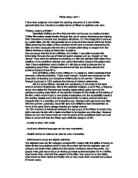Pre-production Thriller Sequence
My opening sequence will be based on the horror genre, but more specifically, on the thriller sub-genre. This sub-genre has many standard conventions and I will examine these conventions along with their effectiveness in influencing the audience.
Conventions are what make up genres and therefore, by using appropriate conventions in a film, the audience is able to quickly recognize the genre and therefore have a better understanding of the plot and what the film is going to be like. More specifically, with knowing the genre, the audience can also then expect to see some of the iconography that is typical for the genre. This can help establish the necessary mood for the film genre, which in the case of thrillers is exciting, suspenseful, tense and full of anxiety and nerve-wracking anticipation. Scenes in thrillers create suspense, tension, and a sense of danger by having the setting in an isolated for example, or by creating scenes where a lot is unseen and unknown to the audience (whether this be the reason behind a situation occurring in the film, or simply a character that is shadowy and that we do not know a lot about).
These icons are used to signify the elements of the thriller genre to the audience. These include such topics as the dark side of life, conspiracies, murders, twisted relationships, danger and suspense. Since they carry symbolic/connotative meaning, colour coding adds to the iconography of thrillers as well. The use of black and white for example, represents or adds to the darkness and evil that is in the play.
I will start my opening sequence by slowly panning across an isolated room. This creates tension already because the audience will feel unsafe in this location, and also because the audience want to see the characters and want to know what is going to be revealed at the end of the panning. The film will have a sepia tone to it, to give a more eerie and untrustworthy atmosphere to the scene. The sepia acts to add suspense to the scene in the same way black and white would, and therefore is basically just a substitute for black and white. Then in my film, we will reach one solitary character in the scene; light from a window hitting him in a harsh way so that his face is not clearly visible. This adds some tension. It makes the audience ask “who is this character?” and especially since we cannot see his face, “does this mean he has a dark past?” Thrillers often use this technique of keeping the personality of a character a mystery to the audience. It gets the audience wondering whether the character is the protagonist or antagonist, until finally it is revealed to them. Then, after this I am going to zoom into an extreme close-up to portray the fury in the character’s eyes. All the techniques I am using, apart from the last one, are subtle; and it is vital that they’re subtle. This is a convention of the thriller sub-genre and thriller films actually try to stay away from gangster and crime related plots; they focus more on the suspense and danger in the film.







